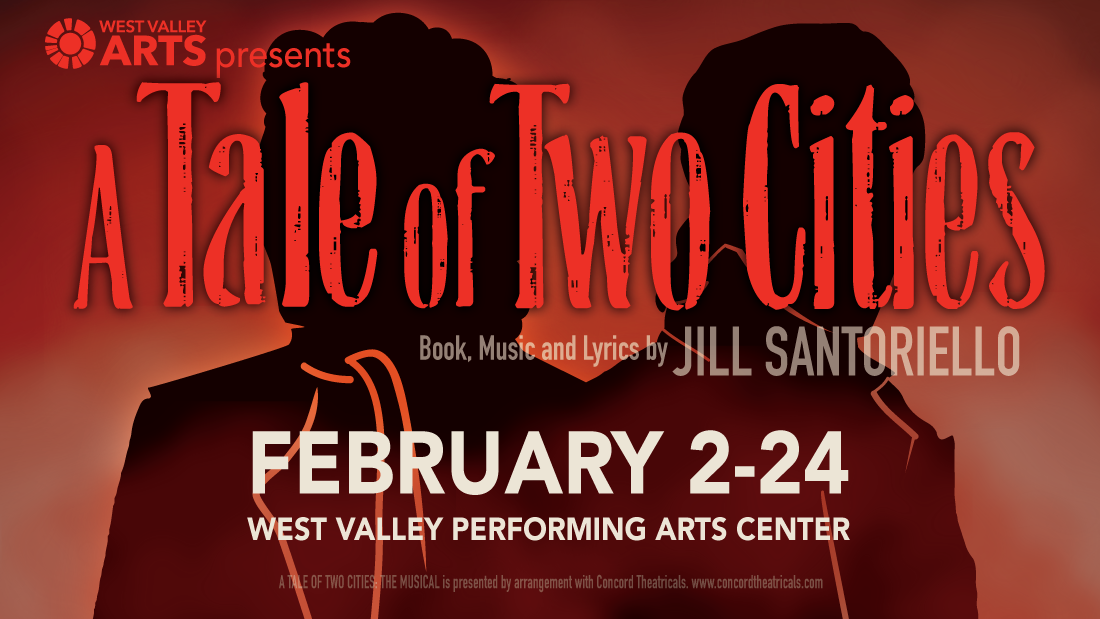WEST VALLEY CITY — On Saturday, February 3 I attended the matinee production of A Tale of Two Cities (with book, music and lyrics by Jill Santoriello) at West Valley Center for the Arts. The story is a two-hour jaunt through France and England right before and during the French Revolution that shares the events from the lens of nobles and commoners alike. Overall, the musical does a good job of carefully balancing the love triangle between Sydney Carton , Lucie Manette and Charles Darney, played by Preston Yates, Brittany Andam and Landon Horton respectively, while simultaneously showcasing the events and people that spur the French peasants into revolution against the aristocrats. The play is a good overview of the book – often citing its most famous quotations, such as, “it was the best of times, it was the worst of times”. The script may even inspire some to read the original text after the show.
The most remarkable aspect of this musical is that it makes use of a spectacular array of stage lighting fixtures. Ryan Fallis’ design consistently uses single spotlights, often with the introduction of each character. The musical opens with a spotlight on Jane Bonner playing Lucie as a child alongside Miss Pross who is played by Linda Jean Stephenson. Those two are accompanied by Jim Dale as Mr. Jarvis Lorry. The lighting mood and style changes accompany almost every song in the musical with many ending in the stage shrouded in darkness. In one of Sidney’s solos, “I Can’t Recall” there are white dots to resemble the night sky scattered among the audience, filling the entire room. It’s a lovely effect that amplifies both the mood and music. In another number, by Marquis St. Evremonde called “Letter from Uncle”, the lights on him are red, then dim to darkness, even as he continues to sing which has a chilling and otherwise ominous effect. In another striking lighting design choice, there’s the use of bloody hand prints that gets most of its usage in the latter portion of the musical. This accents the typical red for blood and violence during seen on stage with Adrien Swenson as Madame Therese DeFarge in her song “Out of Sight, Out of Mind”. It is one of the only numbers in this production that includes sound effects. Designer Dan Morgan’s use of sound is very minimal.

A Tale of Two Cities is great mixture of light-hearted comedy and drama with a bulk of the humor coming from Sydney. There is a cadence to Yates’ speech that isn’t necessarily a dialect, but is so distinct to the character and remains consistent throughout. Sydney is a lush who spends most of his free time at bars; he even spent Christmas Eve drinking in a tavern. His character is single-handedly the most dynamic in the play. Sydney doesn’t grow in the traditional sense, as he’s more like Shrek as a multi-layered onion. Through seeing Sydney’s unrequited love for Lucie, the script peels back the layers of someone who seems disenchanted with life to the powerful ending of the musical.
Sydney’s morose nature character is juxtaposed by the genuine sweetness and kindheartedness of Lucie. Yates and Andam achieved this dynamic exceptionally well. In many moments their chemistry like a delicate balance between Lucie is teasing or flirting with Sydney. Andam pulls this off masterfully. In one scene, when Lucie tells Sydney that she is marrying Charles, it struck me how tender Lucie was in making this difficult confession and made me appreciate Andam’s range as a performer.

The first portion of the play is made of very short scenes, perhaps to get through so much source material, that quickly moves to various relevant plot points and characters. In one moment, adult Lucie goes to find her father, Dr. Manette, played by Jared Haddock, who has been locked away in the French fortress prison, Bastille, for 17 years. The plot quickly shifts to the next scene of Marquis St. Evremonde, played by John Philpott, and his man servant Gaspard, played by Ricky Dowse. This scant scene depth continues in a scene where several Resurrectionists, or in other words grave robbers, have an encounter with Jerry Cruncher’s wife, played by Mackenzie Skye Pedersen while Cruncher and his men are digging. The wife never makes another appearance, and the events of this scene are never mentioned by anyone again. The next scene is with Lucie and Sydney, and completely tonally different and jarring.
Director John Sweeney’s choice to only give accents to a smattering of British characters makes sense. For Americans, British accents are more well known and perhaps easier to mimic than French ones which no one in the play attempts. Although there is no dialect coach listed, everyone’s British accent is remarkably consistent. This is especially true for Daniel Radford who played John Barsad whose charisma and consistency made him a personal favorite by the end of the show. Additionally, Sweeney engaged in some delicate design choices around race conscious casting where Jane Bonner who plays both young Lucie and Lucie’s daughter is given a Black doll to play with in a short scene later on in the play that I deeply appreciated.

A Tale of Two Cities is a musical with a poignant ending that reveals how the Reign of Terror came for any and everyone – not just aristocrats . The show explores how the rage and frustration of the peasants coupled with the almost outlandishly evil actions of a single nobleman can push people over the edge. Yates is a must-see performer. If seeing a show where the entire stage is used, lighting effects radiate, and staging is impressively utilized appeals to you A Tale of Two Cities is the perfect storm of live musical theatre.
[box]The West Valley Arts production of A Tale of Two Cities plays Thursdays through Saturdays at 7:30 PM and Saturdays at 3 PM through February 24 at the West Valley Performing Arts Center (3333 South Decker Lake Drive, West Valley City). Tickets are $18-25. For more information, visit wvcarts.org.[/box]

